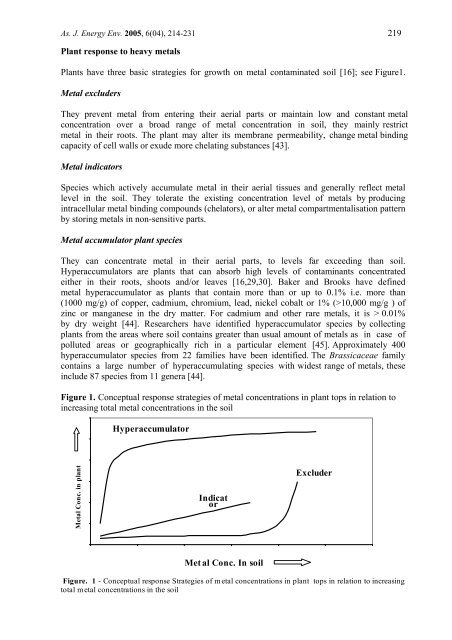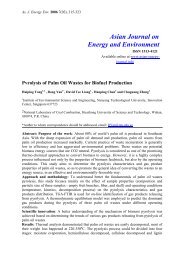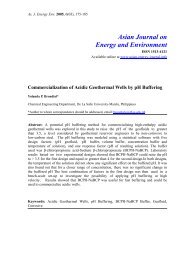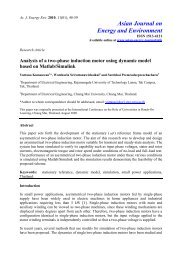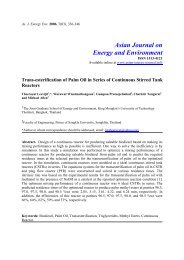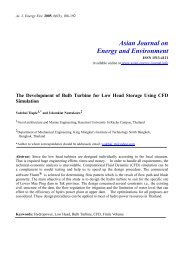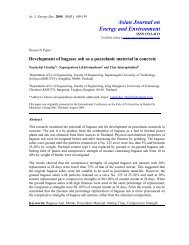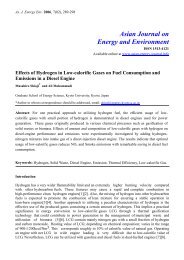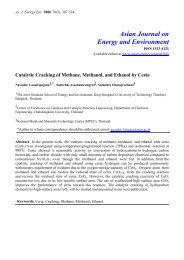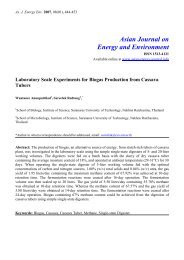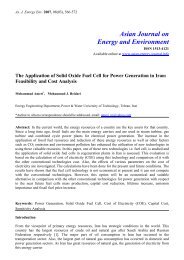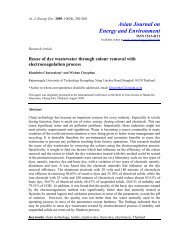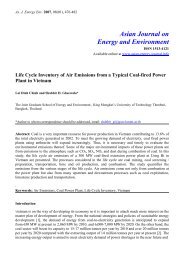A review on phytoremediation of heavy metals and utilisation of it s ...
A review on phytoremediation of heavy metals and utilisation of it s ...
A review on phytoremediation of heavy metals and utilisation of it s ...
You also want an ePaper? Increase the reach of your titles
YUMPU automatically turns print PDFs into web optimized ePapers that Google loves.
As. J. Energy Env. 2005, 6(04), 214-231 219Plant resp<strong>on</strong>se to <strong>heavy</strong> <strong>metals</strong>Plants have three basic strategies for growth <strong>on</strong> metal c<strong>on</strong>taminated soil [16]; see Figure1.Metal excludersThey prevent metal from entering their aerial parts or maintain low <strong>and</strong> c<strong>on</strong>stant metalc<strong>on</strong>centrati<strong>on</strong> over a broad range <strong>of</strong> metal c<strong>on</strong>centrati<strong>on</strong> in soil, they mainly restrictmetal in their roots. The plant may alter <strong>it</strong>s membrane permeabil<strong>it</strong>y, change metal bindingcapac<strong>it</strong>y <strong>of</strong> cell walls or exude more chelating substances [43].Metal indicatorsSpecies which actively accumulate metal in their aerial tissues <strong>and</strong> generally reflect metallevel in the soil. They tolerate the existing c<strong>on</strong>centrati<strong>on</strong> level <strong>of</strong> <strong>metals</strong> by producingintracellular metal binding compounds (chelators), or alter metal compartmentalisati<strong>on</strong> patternby storing <strong>metals</strong> in n<strong>on</strong>-sens<strong>it</strong>ive parts.Metal accumulator plant speciesThey can c<strong>on</strong>centrate metal in their aerial parts, to levels far exceeding than soil.Hyperaccumulators are plants that can absorb high levels <strong>of</strong> c<strong>on</strong>taminants c<strong>on</strong>centratede<strong>it</strong>her in their roots, shoots <strong>and</strong>/or leaves [16,29,30]. Baker <strong>and</strong> Brooks have definedmetal hyperaccumulator as plants that c<strong>on</strong>tain more than or up to 0.1% i.e. more than(1000 mg/g) <strong>of</strong> copper, cadmium, chromium, lead, nickel cobalt or 1% (>10,000 mg/g ) <strong>of</strong>zinc or manganese in the dry matter. For cadmium <strong>and</strong> other rare <strong>metals</strong>, <strong>it</strong> is > 0.01%by dry weight [44]. Researchers have identified hyperaccumulator species by collectingplants from the areas where soil c<strong>on</strong>tains greater than usual amount <strong>of</strong> <strong>metals</strong> as in case <strong>of</strong>polluted areas or geographically rich in a particular element [45]. Approximately 400hyperaccumulator species from 22 families have been identified. The Brassicaceae familyc<strong>on</strong>tains a large number <strong>of</strong> hyperaccumulating species w<strong>it</strong>h widest range <strong>of</strong> <strong>metals</strong>, theseinclude 87 species from 11 genera [44].Figure 1. C<strong>on</strong>ceptual resp<strong>on</strong>se strategies <strong>of</strong> metal c<strong>on</strong>centrati<strong>on</strong>s in plant tops in relati<strong>on</strong> toincreasing total metal c<strong>on</strong>centrati<strong>on</strong>s in the soilHyperaccumulatorMetal C<strong>on</strong>c. in plantIndicatorExcluderMet al C<strong>on</strong>c. In soilFigure. 1 - C<strong>on</strong>ceptual resp<strong>on</strong>se Strategies <strong>of</strong> m etal c<strong>on</strong>centrati<strong>on</strong>s in plant tops in relati<strong>on</strong> to increasingtotal m etal c<strong>on</strong>centrati<strong>on</strong>s in the soil


